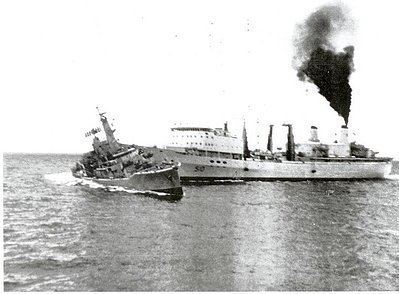Laid down 14 March 1961 Decommissioned 1991 Construction started 14 March 1961 Length 113 m | Commissioned 31 October 1963 Launched 17 August 1962 | |
 | ||
HMS Penelope was a Leander-class frigate of the Royal Navy. Like other ships of the class, Penelope was named after a figure of mythology. She was launched on 17 August 1962 and commissioned on 31 October 1963. Penelope had originally been intended to be part of the Salisbury class and was to have been named Coventry (and before that Panther), but instead became part of the Leander class.
Contents

Construction

Penelope was laid down at Vickers-Armstrongs' Walker shipyard on Tyneside on 14 March 1961, was launched on 17 August 1962. Penelope was commissioned on 31 October 1963 with the Pennant number F127. Total construction cost was £4,600,000.

The ship was 372 feet (113.4 m) long overall and 360 feet (109.7 m) at the waterline, with a beam of 41 feet (12.5 m) and a maximum draught of 18 feet (5.5 m). Displacement was 2,380 long tons (2,420 t) standard and 2,860 long tons (2,910 t) full load. Two oil-fired boilers fed steam at 550 pounds per square inch (3,800 kPa) and 850 °F (454 °C) to a pair of double reduction geared steam turbines that in turn drove two propeller shafts, with the machinery rated at 30,000 shaft horsepower (22,000 kW), giving a speed of 28 knots (52 km/h; 32 mph).

A twin 4.5-inch (113 mm) Mark 6 gun mount was fitted forward. While the Leander-class was planned to be fitted with the Sea Cat surface-to-air missile, Penelope was completed with two Bofors 40 mm anti-aircraft guns as a temporary substitute until Sea Cat could be fitted. A Limbo anti-submarine mortar was fitted aft to provide a short-range anti-submarine capability, while a hangar and helicopter deck allowed a single Westland Wasp helicopter to be operated, for longer range anti-submarine and anti-surface operations.

As built, Penelope was fitted with a large Type 965 long range air search radar on the ship's mainmast, with a Type 993 short range air/surface target indicating radar and Type 974 navigation radar carried on the ship's foremast. An MRS3 fire control system was carried to direct the 4.5-inch guns. The ship had a sonar suite of Type 177 medium range search sonar, Type 162 bottom search and Type 170 attack sonar, together with a Type 199 variable depth sonar (VDS).
Royal Navy service, 1963–1991

After commissioning and workup, Penelope joined the 20th Frigate Squadron which was based at Londonderry Port in Northern Ireland, transferring to the 2nd Frigate Squadron in September 1965. In 1966 Penelope underwent a refit that re-roled her into a trials ship with much of her weaponry and sensors removed or deactivated. The large Type 965 radar was removed, as was the ship's VDS gear and 40 mm guns, while the twin 4.5-in gun turret and fire-control system was cocooned for preservation. She took part in a variety of trials, including tests of different designs of propellers and was refitted in 1970 in preparation for trials of hull noise which involved having her propellers removed and being towed by sister ship Scylla at the end of a 1 mile (1.6 km) long cable. She was also fitted with a prototype Type 184M sonar.
In 1968, Penelope assisted in the aftermath of the Aer Lingus Flight 712 crash in the Irish Sea. There has been a number of conspiracy theories about the crash, including the alleged involvement of Penelope. The theory goes that the ship, while performing tests, mistook the aircraft for a target drone and shot her down. All conspiracy theories have been refuted by the Ministry of Defence, while a 2002 report on the accident by an international study team noted that Penelope was 130 nautical miles (240 km; 150 mi) from the site of the accident, and was not fitted with surface to air missiles. The following year, Penelope was present in West Germany during the Kiel Week festival which combined a yachting race and festival events. In 1973 she underwent another refit to allow her to carry out trials on the Sea Wolf missile. All existing armament was removed, and a Sea Wolf launcher mounted on the ship's flight deck. These trials continued until December 1977, when she started another refit at Devonport Dockyard to return her to an operational frigate and covert her to Batch 2 Exocet configuration.
In 1982, Penelope took part in the Falklands War as part of the "Bristol group", which included two other Leander-class ships - Minerva and Andromeda - she did not reach the Falkland Islands area of operations until 26 May. Upon her arrival, Penelope mainly performed escort duties, including escorting the damaged Argonaut in late May, who had suffered damage after being hit by cannon fire and bombs.
On 13 June, Penelope's Lynx helicopter struck the already stranded Argentinian patrol boat Rio Iguazu with a Sea Skua missile. Penelope returned home in September 1982.
Soon after, Penelope undertook a Falklands patrol in the tense aftermath of the war, and did not return home until June 1983. The following year, she deployed to the South Atlantic again, patrolling and performing other duties in that region. In 1988 the ship suffered a machinery breakdown and collided with the starboard side of the Canadian Naval supply ship HMCS Preserver (AOR 510) during a replenishment. Penelope caught the Preserver's starboard anchor, cutting her port side open. The Canadian vessel suffered $260,000 damage, while Penelope suffered damage estimated in the millions.
Ecuadorian Navy service, 1991–2008
Penelope was decommissioned and subsequently sold, along with Danae, to Ecuador. She was renamed Presidente Eloy Alfaro after President Eloy Alfaro, a prominent Ecuadorian martyred reformer of the early 20th century.
Presidente Eloy Alfaro was decommissioned on 19 March 2008, after 17 years in the Ecuadorian Navy.
